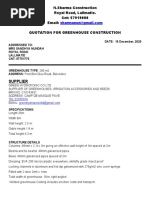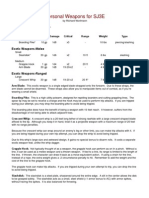Spelljamming Helms: 3e Spelljammer
Spelljamming Helms: 3e Spelljammer
Uploaded by
Maurício JacobCopyright:
Available Formats
Spelljamming Helms: 3e Spelljammer
Spelljamming Helms: 3e Spelljammer
Uploaded by
Maurício JacobOriginal Title
Copyright
Available Formats
Share this document
Did you find this document useful?
Is this content inappropriate?
Copyright:
Available Formats
Spelljamming Helms: 3e Spelljammer
Spelljamming Helms: 3e Spelljammer
Uploaded by
Maurício JacobCopyright:
Available Formats
1.
3e Spelljammer:
Spelljamming Helms
In ages past, the enigmatic blue giants known as the arcane came forward and offered a seafaring tribe of elves an odd item: a large metal throne to be bolted onto a ship. The arcane claimed it would allow them to make the ship fly. More than that, though, they claimed it would allow them to fly their ship through the heavens, from their own world to the other worlds in the night sky. The called it a helm, and they called using it to fly through the stars spelljamming. Since that fateful day the arcane have been selling their spelljamming helms to most any buyer, and they seem to have a limitless supply of these powerful items. Perhaps more surprising is the strangely low prices they charge. While not affordable to the common man, a helm is cheap enough that an entire society of spacefaring people has arisen. A spelljamming helm is typically a chair that is bolted onto the ship it is to propel. They are quite sturdily built, and while they are not adorned with gems or rare metals, they look quite throne-like. They are typically well cushioned and comfortable. A standard helm is designed to fit any medium-size humanoid, and anything smaller can sit in it as well. The arcane build helms to suit other races, though, including up to huge size humanoids. They also build helms for non-humanoid races, such as the dracon or rastipede. Such helms look like low, wide couches. moment. This is normally a standard action, though if it is the first time the helmsman has linked with that helm he must spend 1d4+1 consecutive rounds attuning his mind to the helm. Once the helm is active the helmsman can use any function available (see Helm Functions, below), though it may take some time before he can move. The helm remains active as long as the helmsman remains seated. He cannot end the link by will, but rather must break all contact with the helm. Contact remains as long as at least some small part of the helmsman in contact with the helm. Thus a helmsman could actually stand up from the helm, as long as he had his hand on the helm. Though it takes but a thought to activate a helm, it takes a few moments for the field of magic the helm creates to fully form: 1 second per ton of the ship. In combat situations, divide this time by six and round up to find the number of rounds it takes before the ship can move. The round the helmsman activates the helm counts as the first round. For example, the helmsmen of a hammership (40 tons) are changing shifts. The linked helmsman rises from the helm and the other helmsman sits down. At that moment a pirate ship comes from behind an asteroid. The helmsman sits down the first round, activating the helm. From that point it will take 40 seconds before the ship can move. 40 divided by 6 is 6.7, rounded up to 7. So, on the eighth round the ship can move. As you can see, changing helmsman is not something most ships will want to do when faced with martial conflict. A helmsman can only remain on a helm for a limited time before he starts to become fatigued. Linking with a helm can tire a person out. After twelve consecutive hours on a helmbreaks of less than four hours do not countthe helmsman must make a Fortitude save (DC 12) or suffer 1d6 points of subdual damage and a cumulative 1 to all maneuver rolls. Every hour after the first the DC of the saving throw increases by one (i.e. 13 on the second hour, 14 on the third, and so on). This subdual damage cannot be healed while the helmsman is linked to the helm. If a helmsman takes subdual damage from staying linked to a helm for too long, they cannot relink with that helm until they gain 8 hours of rest and heal any subdual damage they gained from the helm.
Attaching a Helm
In order for a helm to propel a ship it must be firmly attached to a deck on the ship. Helms cannot propel anything smaller than one ton (1,350 cubic feet). A helm has a bolt hole on each leg for bolting the helm to the deck. Each hole must be bolted, otherwise the helm will not activate. Once bolted to the deck the helm must attune itself to the ship. This requires someone to activate the helm (see Activating a Helm, below) and it must remain continually active for one minute per ton of the ship. The helm will not propel the ship until this time is over. Once attuned, the helm need never go through this process with the ship unless it is unbolted and then reattached.
Activating a Helm
A spelljamming helm does not do anything without being linked to someone sitting upon it. Linking to a helm is simple: the helmsman simply sits on the helm and concentrates for a
Authors Note: Helm Prices
I know some people will take a look at the prices I have for helms and believe I am smoking crack. They are going to think that I have made helms far, far too cheap. But, I have my reasons. First, realize that in the campaign setup these prices are designed for, helms are a product exclusive to the Arcane. The prices for helms make no sense when compared to the prices of magic items in the Dungeon Masters Guide, it is true, but when characters are unable to create them it becomes far less of a factor. In my Spelljammer campaigns the goal of the Arcane is not gold, and so they do not charge the customer the normal market price one would expect for such powerful items. They greatly undercharge because they want as many helms in operation as possible. Second, the style of campaign these prices are designed for is one where spelljamming is fairly common. There will be hundreds of active ship in any given sphere at one time, especially very active spheres. Third, the prices of helms and ships are designed to fit into the financial model of Dungeons & Dragons characters. The assumption made here is that in a 3e Spelljammer game the Dungeon Master will reward characters with 25% more gold than in a ground-based campaign, but this gold will go towards buying and maintaining a ship. This means that a group of four characters should have a ship and helm whose total value is approximately the same as the value of each characters other wealth and items. For example, an 11th level character should have total treasure and magic items equal to 66,000 gp. In a Spelljammer campaign, they should have an additional 16,500 gp (25% of 66,000), but this gold is used towards the group ship. If he is a member of a party of four characters, they would have a ship equal to 66,000 gp. This would allow them to own a Squidship plus a Speed 3 spelljamming helm to power it. Also, the lower prices makes it so characters dont get incredibly rich fast by defeating other ships. Lets say the above ship gets into combat with a ship of the same type and defeat it. That will likely be a very tough battle, and so the enemy ship is dropped to 200 hit points and their own ship has been dropped to 300 hit points. Now, they can sell the other helm for half price, which is 12,375 gp. They can also sell the other ship, minus the cost of repair. The normal cost of a Squidship is 37,015 gp, and the DM decides they find someone who will buy it for 28,000 gp minus the repair cost, which is 17,200 gp, for a total of 10,800 gp. Adding in the gold from selling the helm, the parties total haul from the encounter is 23,175 gp. That is a lot of gold, but they also have to fix their own ship, which costs 13,200 gold. That leaves 9,975 gp, which is close to the 9,375 gp suggested reward for an EL 11 encounter in Spelljammer (7,500 + 25%). Now, that doesnt include the value of any treasure NPCs on the other ship have, but then again, that encounter is also likely above EL 11; it is probably closer to EL 13 or 14 if the enemy crew is of a similar level. That leaves plenty of room for their equipment.
Helm Functions
While on the helm the helmsman can perform a number of functions: As a move action the helmsman can switch his perception so he sees whatever he would be able to see if he was standing on any desired point on the outer hull of the ship. This could be the forecastle, the aft deck, from underneath the ship, standing in the crows nest, and so on. Switching to other locations on the ship requires a move action. The acuity of the helmsmans vision is not important; visual acuity is equal to a normal human, so a blind man can see as well as anyone else. The helmsman can make Spot checks as normal. The helm must be bolted and attuned to a ship to use this function. If the helmsman is a spellcaster he can channel his available spell power into the helm, storing it for later use. See Power, below. The helmsman can determine how much power is left in the helm, as well as its maximum speed and the maximum size of ship it can propel. The helmsman can move the ship about, as detailed in the Ship Combat section and Movement and Speed, below. The helm must be bolted and attuned to a ship to use this function. While linked with the helm, the helmsmans basic bodily functions are suppressed; they do not stop, but the effects are not felt. This includes the need to eat, drink and use the bathroom. Once the helmsman unlinks, these needs will return, and the helmsman will likely need to eat a good meal and feed the scaavers. The helm must be bolted and attuned to a ship to use this function.
Helm Types
Although all spelljamming helms function the same, they come in different varieties. There are three ways in which helms differ: long range speed capabilities, maximum tactical speed and the maximum ship size they can move. There are two types of movement for a spelljamming ship: tactical speed and long range speed (often referred to as spelljamming speed). All helms can move a ship at tactical speed, but not all helms can move a ship at spelljamming speed, and such helms cost more. Although all helms propel ships at the same spelljamming speed, not all helms propel ships at the same tactical speed. A helm has a maximum tactical speed, and faster helms cost more. Each helm has a maximum size category of ship it can move. It can move ships smaller than this, though not any larger. Helms capable of moving larger ships cost more. See Table 3 for the cost of helms based on these variations.
Table 1: Power Requirements Maximum Ship Size
Tiny Small Medium Large Huge Gargantuan Colossal
entire time or puttering along at a speed of 1 hex per round, it still requires the same number of power levels. Maximum Power Level Capacity
3 6 12 24 48 96 192
Power Levels per 6 hours
.25 .5 1 2 4 8 16
Helms and Durability
All helms are crafted from Dark Wood, and have hardness 7 and 50 hit points. They have a caster level of 40 for any attepts to dispel them.
New Magic Items
Charge Forcer
This unpleasant item is popular with pirates and slavers, since it removes the need for cooperation from spellcasters in recharging a helm. Charge forcers typically take the form of torqs and other headgear, rarely with any form of decoration or rare stones. The function of a charge forcers is simple: it forces the mind of a spellcaster to link with a helm and channel spells. Thus any spellcaster wearing one that sits upon a helm will be drained of magic, charging the helm, whether they want to or not. The forcer also prevents the wearer from using the helm in any other way. Caster Level: 9th; Prerequisite: charm monster; Market Price: 4,000 gp.
Power
Not all functions of a helm are self-powered. Each helm can hold within itself a reserve of magical energy, which it uses to propel the ship. Normally it gains this powering by siphoning it from a spellcaster. When a spellcaster is linked with a helm he can channel his spells into the power reserve of the helm.This takes a full round and cannot be stopped once it is started. Even if the helmsman breaks the link the helm still draws off his spells. The helm drains all spells from the caster; he cannot choose to hold any spells back from the helm. The power stored by a helm is rated in terms of power levels, and as long as the spellcaster has his full allotment of spells available (i.e. he hasnt cast any of his normal daily allotment of spells, and if he is a spellcaster that is required to prepares spells, he filled all of his spell slots with prepared spells), he channels one power level per caster level. If the spellcaster has cast any spells, or has not filled all available slots with spells, he channels fewer power levels. For each missing spell he channels one less power level. The amount of power a helm can store depends on the size of ship it can move, as shown on Table 1.
Helm Batteries
A helm is capable of storing enough spell power for three full days of operation. But, if the ship is more than three days from a nearby port and finds itself without a spellcaster they are likely in major trouble. This is why many ships carry helm batteries. Table 2: Helm A helm battery is an egg-shaped Battery Prices crystal approximately a foot long and Power Battery eight inches wide, framed along its Capacity Cost major facets with adamantine. It is 3 1,250 gp capable of storing spell power in the 6 2,000 gp 12 3,000 gp same manner as a spelljamming 24 5,000 gp helm. A spellcaster who wishes to 48 8,000 gp channel spells into it simply grasps it 96 12,000 gp with both hands and concentrates 192 17,000 gp on channeling spells into the battery. This takes a full round (and provokes attacks of opportunity), and cannot be stopped once it is started. It works the same as channeling spells into a helm. In order to use the power levels stored within a battery it must be pressed against the helm and the user concentrates for a round (which provokes attacks of opportunity). If successful, all power levels in the battery are transferred to the helm, up to the helms maximum. Remaining power levels remain in the battery and can be used later. Batteries come in different capacities of power levels, which determines their cost; see Table 2. Like helms, they are crafted by the Arcane and no one else has discovered how to create them. Caster Level: 20th; Market Price: See Table 2.
Speed and Movement
There are two types of ship movement. The first is tactical speed. Tactical speed is much like any other type of speed, and is rated in both feet per round and hexes per round. Hexes per round is used in ship combat. All helms can move a ship at tactical speed. The second is long range movement, commonly referred to as spelljamming speed. It is 100 million miles per day, or about 4,166,667 miles per hour. Not all helms are capable of spelljamming speed; those that are capable cost more. See Table 3 for costs. In order to propel the ship the helm must use a number of power levels for every six hours of operation. The number required depends on the size of ship being moved, as shown on Table 1. Power levels are spent at the start of a six hour period, and as long as the helmsman remains linked to the helm it can operate for the full six hours without draining additional power levels, even if it stops and starts during that time. If the helmsman breaks the link with the helm and then relinks, or a different person links with the helm, a new six hour period starts. How the ship moves during a six hour period is not important. Whether it is traveling at spelljamming speed the
Table 3: Helm Costs Spelljamming Speed Capable
Maximum Spellcaster Ship Levels Per Size 6 hours Tiny Small Medium Large Huge Gargantuan Colossal 0.25 0.5 1 2 4 8 16 Speed 1 (150 feet) 2,444 gp 3,667 gp 5,500 gp 8,250 gp 12,375 gp 18,562 gp 27,844 gp Speed 2 (300 feet) 4,889 gp 7,333 gp 11,000 gp 16,500 gp 24,750 gp 37,125 gp 55,687 gp Speed 3 (450 feet) 7,333 gp 11,000 gp 16,500 gp 24,750 gp 37,125 gp 55,688 gp 83,531 gp Speed 4 (600 feet) 9,778 gp 14,667 gp 22,000 gp 33,000 gp 49,500 gp 74,250 gp 111,375 gp Speed 5 (750 feet) 12,222 gp 18,333 gp 27,500 gp 41,250 gp 61,875 gp 92,812 gp 139,219 gp Speed 6 (900 feet) 14,667 gp 22,000 gp 33,000 gp 49,500 gp 74,250 gp 111,375 gp 167,063 gp Speed 7 Speed 8 Speed 9 (1,050 feet) (1,200 feet) (1,350 feet) 19,556 gp 29,333 gp 44,000 gp 66,000 gp 99,000 gp 148,500 gp 222,750 gp 24,444 gp 36,667 gp 55,000 gp 82,500 gp 123,750 gp 185,625 gp 278,437 gp 29,333 gp 44,000 gp 66,000 gp 99,000 gp 148,500 gp 222,750 gp 334,125 gp
Tactical Speed Capable Only
Maximum Spellcaster Ship Levels Per Size 6 hours Tiny Small Medium Large Huge Gargantuan Colossal 0.25 0.5 1 2 4 8 16 Speed 1 (150 feet) 1,210 gp 1,815 gp 2,723 gp 4,084 gp 6,126 gp 9,188 gp 13,783 gp Speed 2 (300 feet) 2,420 gp 3,630 gp 5,445 gp 8,168 gp 12,251 gp 18,377 gp 27,565 gp Speed 3 (450 feet) 3,667 gp 5,500 gp 8,250 gp 12,375 gp 18,563 gp 27,844 gp 41,766 gp Speed 4 (600 feet) 4,877 gp 7,315 gp 10,973 gp 16,459 gp 24,688 gp 37,032 gp 55,548 gp Speed 5 (750 feet) 6,087 gp 9,130 gp 13,695 gp 20,543 gp 30,814 gp 46,221 gp 69,331 gp Speed 6 (900 feet) 7,333 gp 11,000 gp 16,500 gp 24,750 gp 37,125 gp 55,688 gp 83,531 gp Speed 7 Speed 8 Speed 9 (1,050 feet) (1,200 feet) (1,350 feet) 9,753 gp 14,630 gp 21,945 gp 32,918 gp 49,376 gp 74,064 gp 111,097 gp 12,173 gp 18,260 gp 27,390 gp 41,085 gp 61,628 gp 92,441 gp 138,662 gp 14,667 gp 22,000 gp 33,000 gp 49,500 gp 74,250 gp 111,375 gp 167,063 gp
Life Forcer
This item is similar to both lifejammers and charge forcers, looking much like the latter. It converts life force energy into magical energy, allowing a person to sit upon a standard helm and recharge it with their own life force. The person using it has complete control, and must be conscious to use it. They user can choose to channel as many of their hit points into the helm as they wish, in five point increments, charging the helm 1 power level per five hit points drained. It will not work for anyone at less than one hit point, nor will it drop anyone below zero. As with the lifejammer, any hit points used in recharging can only be recovered through natural healing over time, not any sort of magic. On the upside, the life forcer prevents people who use it from dying or feeling anything other than slight discomfort. Those who use it still have their appearance temporarily affected, as with a lifejammer. Despite similarities, the life forcer is designed to server a different purpose than either the lifejammer or the charge forcer. Where those items are primarily used by pirates and slavers to draw out as much free energy as they can from their victims, the life forcer is used primarily as a backup in case of emergencies. They tend to be relatively cheap and common, countered by the price for using one, and are sometimes thrown in as a package deal on helms, similar to planetary locators. Like helms, life forcerers are crafted by the Arcane and no one else has discovered how to create them. Caster Level: 20th; Market Price: 4,000 gp.
Lifejammer
A lifejammer is an insidious device that is attached to a spelljamming helm that allows the helms to be charged by life force rather than magical energy. It looks like a coffin shaped metal box that is mounted to the back of a helm at an angle, one and at the top of the helm. This box is eight feet long, three feet wide and three feet deep. It has a hinged metal lid with numerous air holes, and a bolt for locking. Helms with a lifejammer attached can be charged normally, or they can be charged by the life force of the person in the box. To charge the helm, a living creature must be placed in the box, and someone must be linked with the helm. The person on the helm will become aware of the health of the creature (i.e. its current hit points). They can then choose to siphon as many of these hit points away as they wish, in five point increments, charging the helm 1 power level per five hit points drained. Any creature that is dropped to less than zero hit points while in the box dies, regardless of how much was drained from them. Anyone already at zero or below dies without granting power levels. Even if someone is only partially drained, they must make a Fortitude saving throw (DC 12) or die. Lifejammers are slower to recharge, taking one full round per hit point drained, although the helm can do this while also propelling the ship. The person being drained of their life force suffers pain of the most intense and severe sort, and few can take it without screaming and trying to claw their way out of the box. Damage taken from charging a lifejammer cannot be healed by magic or first aid; it can only be healed by time. Although this damage is not actually visible (i.e. no visible wounds or scars), drained characters become rather ashen and sickly looking, with the severity depending on how much they
were drained. Someone drained to 1 hit point would look like a walking corpse, with greyish, loose flesh and sunken eyes. The lifejammer is considered by most to be a truly evil item, and that fact that the arcane seem just as willing to sell them as they are helms brings many to question their morality and motivations. The lifejammer is mostly used by pirates and slavers of the most evil sort, such as the neogi, since even typical pirates and slavers find them too grim to use; it is one thing to raid a ship or sell someone into slavery, it is another to murder them by sucking out their soul. Like helms, lifejammers are crafted by the Arcane and no one else has discovered how to create them. Caster Level: 20th; Market Price: 25,000 gp.
You might also like
- SorcererDocument113 pagesSorcererMaurício Jacob88% (17)
- Mage Made Easy Advice From That Damn Mage GuyDocument61 pagesMage Made Easy Advice From That Damn Mage Guymarkletter94% (18)
- D&D 3E Spelljammer Ship Construction OCRDocument15 pagesD&D 3E Spelljammer Ship Construction OCRJ'uar100% (8)
- Flow MapDocument1 pageFlow MapFaz Maldov100% (2)
- Flow MapDocument1 pageFlow MapFaz Maldov100% (2)
- Intern 2 Report Nguyễn Phan Hoàng Minh IELSIU18078Document47 pagesIntern 2 Report Nguyễn Phan Hoàng Minh IELSIU18078Thao PhamNo ratings yet
- Spelljammer ConstructionDocument10 pagesSpelljammer ConstructionDale Norman100% (3)
- D&D 3.5 Web - Magic Books of FaerunDocument47 pagesD&D 3.5 Web - Magic Books of FaerunVassilis TsipopoulosNo ratings yet
- Paladin Variants: Options For Non-Good Patron DeitiesDocument12 pagesPaladin Variants: Options For Non-Good Patron DeitiesAnonymous 05VM7O27oNo ratings yet
- Epic Insights CompilationDocument55 pagesEpic Insights CompilationVince DeStefano100% (1)
- AD&D - Complete Manual of DrowDocument51 pagesAD&D - Complete Manual of Drowapi-19625324100% (1)
- D&D 3E Spelljammer Converted Creatures OCRDocument228 pagesD&D 3E Spelljammer Converted Creatures OCRJ'uar80% (5)
- D&D 3.5e Airship and Flying City Creation GuideDocument12 pagesD&D 3.5e Airship and Flying City Creation GuideSadisticSeraph100% (3)
- Return To Manitou Bluff PDFDocument161 pagesReturn To Manitou Bluff PDFMaurício Jacob100% (3)
- Blood Drive 2 - High Plains DroversDocument37 pagesBlood Drive 2 - High Plains DroversMaurício Jacob100% (2)
- QuotationDocument2 pagesQuotationSandhya Nundah100% (1)
- Ship Combat: 3e SpelljammerDocument18 pagesShip Combat: 3e Spelljammeranthony_m_orlandoNo ratings yet
- Spelljammer 5E Conversion (Shorter)Document7 pagesSpelljammer 5E Conversion (Shorter)Fausto Passarelli100% (2)
- d20 - Spelljammer - Ship Combat RulesDocument1 paged20 - Spelljammer - Ship Combat RulesEruditus100% (1)
- Spelljammer CombatDocument29 pagesSpelljammer Combatmichael.silverbane5351100% (3)
- Spelljammer - D20 - WeaponsDocument1 pageSpelljammer - D20 - Weaponscorwyn100% (1)
- 201 Trobriands MachinationsDocument6 pages201 Trobriands Machinationsyugolord8920No ratings yet
- Spelljammer 3rd Edition Ship Building RulesDocument16 pagesSpelljammer 3rd Edition Ship Building Rulesbamilo100% (4)
- Chris Dickinson Spelljammer Mailing List Aaron Siddall StaticDocument13 pagesChris Dickinson Spelljammer Mailing List Aaron Siddall StaticSteampunkObrimos100% (1)
- Oriental Adventures and Spelljammer GuideDocument67 pagesOriental Adventures and Spelljammer Guidecos2in100% (2)
- Guide To The SpheresDocument36 pagesGuide To The Spheresfulkerp100% (1)
- Drizzt ItemsDocument17 pagesDrizzt ItemsfhaskellNo ratings yet
- Practical Spelljamming For Modern SpacefarersDocument32 pagesPractical Spelljamming For Modern SpacefarersHiram Lopez Villarreal100% (2)
- Spelljamming For DummiesDocument5 pagesSpelljamming For DummiesGregory Prest100% (1)
- Spelljammer in 5eDocument23 pagesSpelljammer in 5eTrab SnirpNo ratings yet
- Spelljammer, Other Races - GM BinderDocument4 pagesSpelljammer, Other Races - GM BinderRyan Lowder100% (4)
- Spelljammer SkillsDocument2 pagesSpelljammer SkillsAlexander DeMossNo ratings yet
- Interactive Rifts SheetDocument4 pagesInteractive Rifts SheetMatthew Stump100% (1)
- (AD&D 2nd Edition) Spelljammer - Monstrous Compendium - Volume IVDocument46 pages(AD&D 2nd Edition) Spelljammer - Monstrous Compendium - Volume IVKevin Lee Elam100% (4)
- Urdunnir Dwarf - A DND Wiki - WikiaDocument3 pagesUrdunnir Dwarf - A DND Wiki - WikiasteelescottNo ratings yet
- Forgotten Realms Boxed Sets 2nd Edition ListDocument7 pagesForgotten Realms Boxed Sets 2nd Edition ListRaistzNo ratings yet
- Spelljammer Campaign Guide 2011Document75 pagesSpelljammer Campaign Guide 2011Faz Maldov100% (2)
- MechanusDocument33 pagesMechanusfulkerpNo ratings yet
- Underdark CitiesDocument3 pagesUnderdark CitiesSteven AllenNo ratings yet
- Warforged ParagonDocument4 pagesWarforged ParagonTony Holcomb100% (1)
- D20 Mounts GuideDocument32 pagesD20 Mounts GuideDavidArcher100% (3)
- Yugoloth ResourceDocument7 pagesYugoloth ResourceLuigi CaizziNo ratings yet
- Wizard Path School of Summoning 5eDocument3 pagesWizard Path School of Summoning 5eGdawg100% (4)
- Spelljammer - 1d4chanDocument2 pagesSpelljammer - 1d4chankalam60029No ratings yet
- Vestiges CompendiumDocument21 pagesVestiges CompendiumMaximilian Schmidt100% (1)
- Feyling Race - Dryad Treantling and Satyr (10598835)Document3 pagesFeyling Race - Dryad Treantling and Satyr (10598835)Oscar Chacon100% (1)
- Nymmurh, The Wyrm Who Watches - Helvenblade House - Bronze DragonDocument7 pagesNymmurh, The Wyrm Who Watches - Helvenblade House - Bronze DragonSébastien RichemontNo ratings yet
- Fantasy Foundry (10032611)Document8 pagesFantasy Foundry (10032611)Oscar Chacon100% (1)
- Wild Dwarf Character TraitsDocument2 pagesWild Dwarf Character Traitsclimber85100% (1)
- d20 4e One Bad Egg Poisoncraft The Codex VenenorumDocument51 pagesd20 4e One Bad Egg Poisoncraft The Codex VenenorumDominic TurcotteNo ratings yet
- 5e Skyships A1 PDFDocument23 pages5e Skyships A1 PDFDracowyrm100% (7)
- D&D 5e - Races of TamrielDocument6 pagesD&D 5e - Races of TamrielJacobNo ratings yet
- Web Enhacement - Planescape - The Roaming Genasi TavernDocument46 pagesWeb Enhacement - Planescape - The Roaming Genasi TavernGarret CraigNo ratings yet
- D&D 5E ShapeshifterDocument1 pageD&D 5E ShapeshifterSteve W.No ratings yet
- Word of KansenDocument5 pagesWord of KansenbismarckinmotionkingoftheoceanNo ratings yet
- StarsailingDocument3 pagesStarsailingdream.dhsf00No ratings yet
- Naval Combat - Pathfinder 2e - GM BinderDocument26 pagesNaval Combat - Pathfinder 2e - GM BinderRodrigo Moraes100% (2)
- Theatre of The Mind Ship Combat Rules - 5-8Document4 pagesTheatre of The Mind Ship Combat Rules - 5-8No Thank YouNo ratings yet
- DND Arcane Vehicles - Astral ShipsDocument14 pagesDND Arcane Vehicles - Astral ShipsYTGG SugarNo ratings yet
- 893392-RTG_-_Hyperspeed_Playtest_-_v0.1Document10 pages893392-RTG_-_Hyperspeed_Playtest_-_v0.1Fake BameNo ratings yet
- Spelljammer Combat Expanded v1.3Document16 pagesSpelljammer Combat Expanded v1.3Mimsy100% (1)
- And A Bottle of RumDocument7 pagesAnd A Bottle of RumAbdel AdrianNo ratings yet
- Oldhammer AhoyDocument14 pagesOldhammer AhoyChristopher CaleNo ratings yet
- Spelljammer Combat and ExplorationDocument107 pagesSpelljammer Combat and ExplorationEric Monachon0% (1)
- ArsMagica5 CovenantsDocument139 pagesArsMagica5 CovenantsPhil Harvey100% (2)
- Tsr09169 - I8 Ravager of TimeDocument38 pagesTsr09169 - I8 Ravager of TimeMaurício Jacob100% (1)
- Dragon Magazine 336 - Birth of Dead, Origins of The Walking DeadDocument11 pagesDragon Magazine 336 - Birth of Dead, Origins of The Walking DeadMaurício JacobNo ratings yet
- Deadlands Reloaded Preview PDFDocument5 pagesDeadlands Reloaded Preview PDFMaurício JacobNo ratings yet
- For Whom The Whistle BlowsDocument40 pagesFor Whom The Whistle BlowsMaurício Jacob100% (4)
- Weird War II Dead From Above - PinnacleDocument66 pagesWeird War II Dead From Above - PinnacleMaurício Jacob100% (4)
- Grain and Soybean Drying On Georgia FarmsDocument13 pagesGrain and Soybean Drying On Georgia FarmsjimNo ratings yet
- Lesson 7 - Winglets, Raked Wingtips, Vortices, DragDocument38 pagesLesson 7 - Winglets, Raked Wingtips, Vortices, Dragaahsan345No ratings yet
- Climate Change and Its Impact on Global Agriculture A Growing Threat to Food SecurityDocument2 pagesClimate Change and Its Impact on Global Agriculture A Growing Threat to Food SecurityAkshay WaimNo ratings yet
- Anemia NCPDocument5 pagesAnemia NCPMel Christian Baldoz100% (2)
- Full Download Design of Guidance and Control Systems for Tactical Missiles 1st Edition Qi Zaikang (Author) PDF DOCXDocument55 pagesFull Download Design of Guidance and Control Systems for Tactical Missiles 1st Edition Qi Zaikang (Author) PDF DOCXsaponrinasub100% (5)
- Manual Generator HVP-80Document1 pageManual Generator HVP-80kiran kumarNo ratings yet
- Newsletter Edition1 Sept2014Document5 pagesNewsletter Edition1 Sept2014Ian K. GrayNo ratings yet
- Quantification of Amphetamine and Derivatives in Oral Fluid by Dispersed Liquid Liquid Micro Extraction and LC-MSDocument7 pagesQuantification of Amphetamine and Derivatives in Oral Fluid by Dispersed Liquid Liquid Micro Extraction and LC-MSkassim AliNo ratings yet
- Vista Explodida Modelos 12 A 48Document22 pagesVista Explodida Modelos 12 A 48Caio Guarnieri DuarteNo ratings yet
- 03 Russo & Viggiani KeynoteDocument20 pages03 Russo & Viggiani KeynotepierussoNo ratings yet
- Redisson Blu RudrapurDocument59 pagesRedisson Blu RudrapurKailash JoshiNo ratings yet
- On EmpathyDocument11 pagesOn EmpathyPaulina EstradaNo ratings yet
- KubotaDocument1 pageKubotaRETIFICA ITATIBANo ratings yet
- Seating ArrangementDocument32 pagesSeating ArrangementBONI TARUNNo ratings yet
- Simulation and Optimization of 2 X 2 Mach-ZehnderDocument19 pagesSimulation and Optimization of 2 X 2 Mach-ZehnderKenjal JainNo ratings yet
- Sachpazis Cantilever Steel Sheetpile Retaining Wall Analysis Design Free Earth Support To Eurocode 7Document14 pagesSachpazis Cantilever Steel Sheetpile Retaining Wall Analysis Design Free Earth Support To Eurocode 7rowatersNo ratings yet
- The Seven Organisational Levels of DiscourseDocument9 pagesThe Seven Organisational Levels of DiscourseEddy Kloprogge100% (1)
- Control Valves PDFDocument6 pagesControl Valves PDFIlham Bayu TiasmoroNo ratings yet
- Chap 10 AntennaDocument13 pagesChap 10 AntennaHemil BhattNo ratings yet
- Glass - Unit V Aesthetics of Glass ArchitectiureDocument16 pagesGlass - Unit V Aesthetics of Glass ArchitectiureASWIN KUMAR N SNo ratings yet
- Connect Diary - 2017 - 01062017Document450 pagesConnect Diary - 2017 - 01062017Girish RajputNo ratings yet
- NL Historyofcoffee Adv Ws 954383-3Document5 pagesNL Historyofcoffee Adv Ws 954383-3Maria TowersNo ratings yet
- Rules of Chart Interpretation and Evaluation of Polygraph ResultsDocument8 pagesRules of Chart Interpretation and Evaluation of Polygraph ResultsNick clarence SolimanNo ratings yet
- Modifier in English Grammar With Examples PDFDocument7 pagesModifier in English Grammar With Examples PDFhemisphereph2981No ratings yet
- Java LabDocument28 pagesJava LabNavneet Singh BhakuniNo ratings yet
- Fri 3 Jan 2020 06.00 GMT: @alexhernDocument3 pagesFri 3 Jan 2020 06.00 GMT: @alexhernOmar BasemNo ratings yet
- Gasmet EMISSIONS MONITORING HANDBOOKDocument36 pagesGasmet EMISSIONS MONITORING HANDBOOKChakir KasdarliNo ratings yet
- Chapter 5 Stacks and QueuesDocument23 pagesChapter 5 Stacks and QueuesEmulatorNo ratings yet



































































































